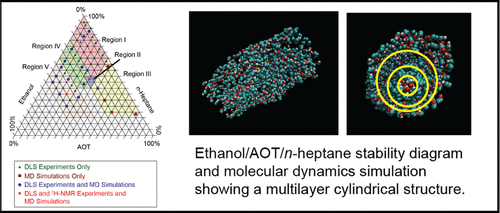Our official English website, www.x-mol.net, welcomes your feedback! (Note: you will need to create a separate account there.)
Phase Stability and Miscibility in Ethanol/AOT/n-Heptane Systems: Evidence of Multilayered Cylindrical and Spherical Microemulsion Morphologies.
Langmuir ( IF 3.9 ) Pub Date : 2020-09-08 , DOI: 10.1021/acs.langmuir.0c01851 Robyn E Ridley 1 , Erick Alvarado 1 , Anthony A Mrse 2 , Victor R Vasquez 3 , Olivia A Graeve 1
Langmuir ( IF 3.9 ) Pub Date : 2020-09-08 , DOI: 10.1021/acs.langmuir.0c01851 Robyn E Ridley 1 , Erick Alvarado 1 , Anthony A Mrse 2 , Victor R Vasquez 3 , Olivia A Graeve 1
Affiliation

|
We describe the effects of ethanol on the phase behavior of sodium bis(2-ethylhexyl) sulfosuccinate (AOT) in n-heptane. Using dynamic light scattering (DLS), molecular dynamics (MD) simulations, and nuclear magnetic resonance (1H NMR) spectroscopy, we investigate the aggregation behavior of AOT across a wide range of ethanol/AOT/n-heptane compositions. We conclude that reverse micelles do not form at any of the investigated concentrations. Instead, we observe the formation of other surfactant aggregate morphologies unique to this system, namely, multilayered cylindrical structures and spherical AOT-in-ethanol structures, which vary significantly with changes in ethanol concentration. We also identify mixed-solvent polarity as a driving factor for the surfactant behavior in the system. When the concentration of ethanol is 20 wt % or below, the system is inhomogeneous with varying sizes of AOT, ethanol, and AOT + ethanol aggregates, with the ethanol primarily exhibiting a cosurfactant behavior, almost exclusively binding at the surface of AOT aggregates. With increased ethanol concentration, the ethanol in the system also exhibits solvent-like behaviors in addition to the cosurfactant behaviors. Most significantly, when the ethanol concentration is raised above 35 wt %, the transition to solvent-like behavior allows AOT Na+ counterions to dissociate from the headgroups and they are dissolved in the ethanol. We use these results to construct a preliminary phase diagram for the ethanol/AOT/n-heptane system.
中文翻译:

乙醇/ AOT /正庚烷体系中的相稳定性和可混溶性:多层圆柱形和球形微乳液形态的证据。
我们描述乙醇对双(2-乙基己基)磺基琥珀酸钠(AOT)在正庚烷中的相行为的影响。使用动态光散射(DLS),分子动力学(MD)模拟和核磁共振(1 H NMR)光谱,我们研究了AOT在广泛的乙醇/ AOT / n中的聚集行为-庚烷组合物。我们得出结论,在任何研究浓度下均不形成反胶束。相反,我们观察到该系统独有的其他表面活性剂聚集体形态的形成,即多层圆柱结构和球形AOT-in-ethanol结构,它们随乙醇浓度的变化而显着变化。我们还将混合溶剂的极性确定为系统中表面活性剂行为的驱动因素。当乙醇的浓度为20 wt%或更低时,该系统是不均匀的,具有不同大小的AOT,乙醇和AOT +乙醇聚集体,乙醇主要表现出辅助表面活性剂的行为,几乎仅在AOT聚集体表面结合。随着乙醇浓度的增加,除了助表面活性剂,系统中的乙醇还表现出类似溶剂的行为。最重要的是,当乙醇浓度提高到35 wt%以上时,向溶剂样行为的转变使AOT Na+抗衡离子从头基解离,它们溶解在乙醇中。我们使用这些结果来构建乙醇/ AOT /正庚烷体系的初步相图。
更新日期:2020-09-29
中文翻译:

乙醇/ AOT /正庚烷体系中的相稳定性和可混溶性:多层圆柱形和球形微乳液形态的证据。
我们描述乙醇对双(2-乙基己基)磺基琥珀酸钠(AOT)在正庚烷中的相行为的影响。使用动态光散射(DLS),分子动力学(MD)模拟和核磁共振(1 H NMR)光谱,我们研究了AOT在广泛的乙醇/ AOT / n中的聚集行为-庚烷组合物。我们得出结论,在任何研究浓度下均不形成反胶束。相反,我们观察到该系统独有的其他表面活性剂聚集体形态的形成,即多层圆柱结构和球形AOT-in-ethanol结构,它们随乙醇浓度的变化而显着变化。我们还将混合溶剂的极性确定为系统中表面活性剂行为的驱动因素。当乙醇的浓度为20 wt%或更低时,该系统是不均匀的,具有不同大小的AOT,乙醇和AOT +乙醇聚集体,乙醇主要表现出辅助表面活性剂的行为,几乎仅在AOT聚集体表面结合。随着乙醇浓度的增加,除了助表面活性剂,系统中的乙醇还表现出类似溶剂的行为。最重要的是,当乙醇浓度提高到35 wt%以上时,向溶剂样行为的转变使AOT Na+抗衡离子从头基解离,它们溶解在乙醇中。我们使用这些结果来构建乙醇/ AOT /正庚烷体系的初步相图。



























 京公网安备 11010802027423号
京公网安备 11010802027423号